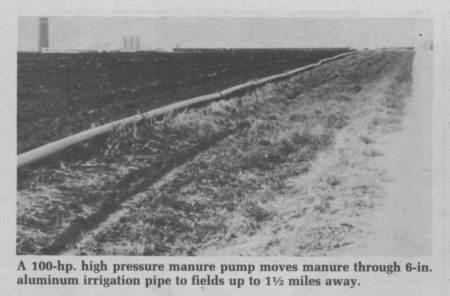
Every year, Gary Main's 400 feeder cattle and 6,000 market hogs produce enough waste material to fill a million-gallon holding tank twice. "Disposing of liquid manure is my biggest headache," the Altona, Ill. farmer says.
Alton Irrigation, Inc., of Rock Falls, Ill., comes to the rescue of farmers like Main, who in the past has used the conventional method of pumping liquid manure into a 3,000-gal. tank spreader and then injecting it into the soil. Main says it took 10 days to empty the holding tank, and the heavy spreader's trips across the field contributed to soil compaction.
Alton Irrigation accomplished the job in three days by pumping manure through irrigation pipe and flexible tubing to a tractor-mounted applicator that injects the manure directly into the ground.
On Main's farm, liquid manure was pumped from the holding tank through 6,000 ft. of 6-in. aluminum irrigation pipe at a rate of 450 gal. per min. When pumping a shorter distance, the rate is 600 gal. per min., according to company president Rick Alton.
A 100 hp high-pressure manure pump was used to pump the manure from the holding tank to fields up to 1 1/2 miles away. Alton says the company uses several different brands of pumps.
For manure that contains bedding he sometimes uses a chopper pump. The irrigation pipe runs along ditches, along fence rows and through culverts to reach fields.
In the field, two 660-ft. sections of 4 1/2-in. flexible hose were used. One hose attaches to an applicator mounted on the rear of a tractor and allows the tractor to travel about 1,500 ft. up and down the field. Another tractor moves the second hose approximately 40 ft. after every two rounds made by the applicator, which allows manure to be injected over 40 acres at once without shutting off the pump.
Alton Irrigation built the 10-ft. wide applicator with five 24-in. sweeps that inject the waste materials 6 in. beneath the soil surface. Alton says the company can build injector manifolds to mount on any brand of chisel plow. The manure usually is applied at a rate of 10,000 to 15,000 gal. per acre. Alton recommends that farmers have a soil test and an analysis of the manure to determine the rate at which it should be injected.
Alton Irrigation provides a two-man crew to do the job and asks the farmer to provide two tractors and one employee. Field workers communicate via walkie talkie with the pump operator. It usually takes a full day to lay the pipe and hoses. In one 10-hr. day on Main's farm, the crew applied 270,000 gal. of liquid manure, the equivalent of 90 loads with Main's tank spreader.
Main says if he were using the tank spreader, he would consider 60,000 gal. spread "a real good day."
Alton says he can pump liquid manure as far as two miles. "The farther you go, the less amount you can apply," he notes. "Beyond two miles, you're approaching the limit of what is economically feasible."
He says the work can continue until temperatures fall to approximately 20 degrees Fahrenheit. He has injected the manure into 8 in. of snow which soon melted into the ground.
"The real benefit is that we can go in and in two days' time, do what a farmer can do in two weeks," he adds.
